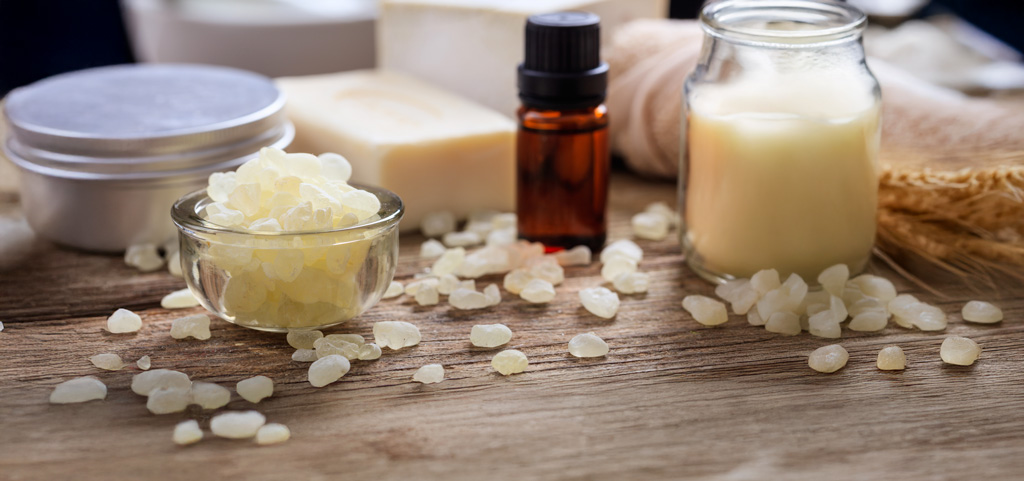
Retinol alternatives
Skin care
peer-reviewed
More than anti-ageing: the retinol-alternative Chios mastic as a comprehensive approach for skin & scalp
EVA BOENZLI1*, KATHARINA KAPPLER1, STÉPHANE POIGNY2, FRED ZUELLI3, FRANZISKA WANDREY4
1. Scientific Project Manager, 2. Director R&D, France, 3. Business Development Director, 4. Head of Research
Mibelle Biochemistry, Switzerland
*Corresponding author
ABSTRACT: Mastic, a natural resin from Pistacia lentiscus, is known for its anti-ageing effects and ability to ameliorate skin properties by inhibiting CYP26, an enzyme that degrades retinoic acid in the skin. This inhibition leads to increased endogenous retinoic acid levels and improved skin appearance, including reduced impurities, enhanced elasticity, density, and sebum regulation. Recent clinical findings extend these benefits to the scalp, where mastic from Chios Island significantly reduced dandruff and Malassezia yeast. These effects are likely mediated by keratinocyte regulation, sebum control, and skin barrier support. Thus, Chios mastic emerges as a multifunctional active for facial skin and scalp. This study evaluated its efficacy as a natural alternative to retinol in promoting both skin and scalp health.
??????????????????
“
“A study in healthy women providing probiotic yogurt for four weeks showed an improvement in emotional responses as measured by brain scans”
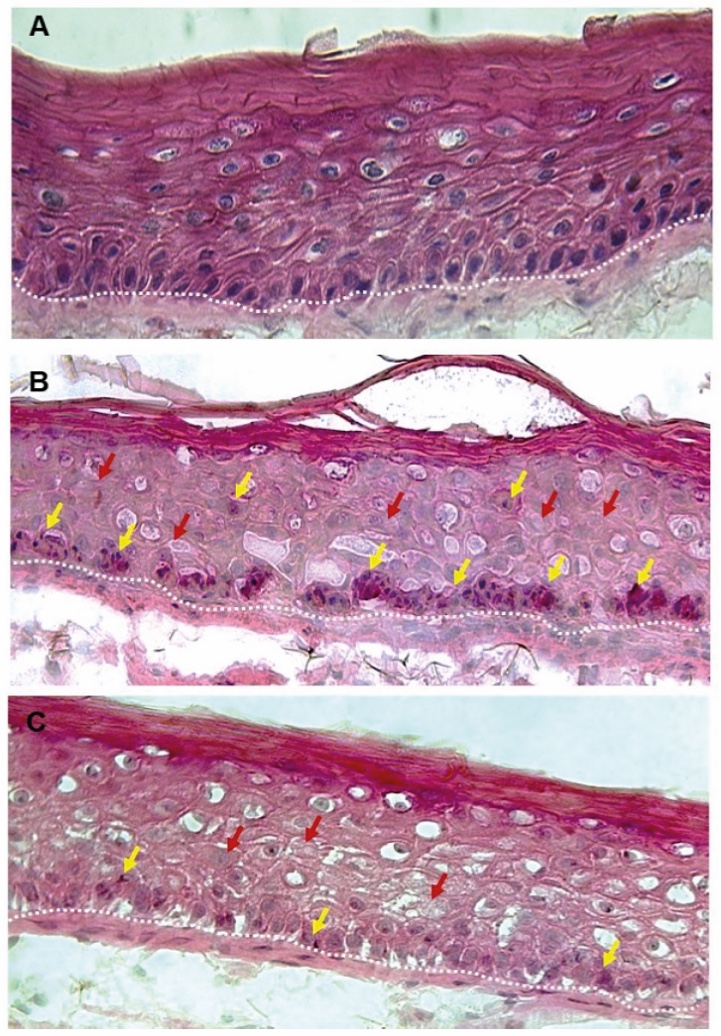
Figure 1. Skin Section with Microbiome. Most microorganisms live in the superficial layers of the stratum corneum and in the upper parts of the hair follicles. Some reside in the deeper areas of the hair follicles and are beyond the reach of ordinary disinfection procedures. There bacteria are a reservoir for recolonization after the surface bacteria are removed.
Materials and methods
Studies of major depressive disorder have been correlated with reduced Lactobacillus and Bifidobacteria and symptom severity has been correlated to changes in Firmicutes, Actinobacteria, and Bacteriodes. Gut microbiota that contain more butyrate producers have been correlated with improved quality of life (1).
A study in healthy women providing probiotic yogurt for four weeks showed an improvement in emotional responses as measured by brain scans (2). A subsequent study by Mohammadi et al. (3) investigated the impacts of probiotic yogurt and probiotic capsules over 6 weeks and found a significant improvement in depression-anxiety-stress scores in subjects taking the specific strains of probiotics contained in the yogurt or capsules. Other studies with probiotics have indicated improvements in depression scores, anxiety, postpartum depression and mood rating in an elderly population (4-7).
Other studies have indicated a benefit of probiotic supplementation in alleviating symptoms of stress. In particular, researchers have looked at stress in students as they prepared for exams, while also evaluating other health indicators such as flu and cold symptoms (1). In healthy people, there is an indication that probiotic supplementation may help to maintain memory function under conditions of acute stress.
Introduction
The role of retinoids in skincare: benefits, limitations, and emerging alternatives
Retinoids, derivatives of vitamin A, are essential in dermatology and skincare due to their ability to promote cell turnover, stimulate collagen production, reduce signs of ageing, regulate keratinocyte proliferation, support wound healing, and strengthen the skin barrier (1). They are also used therapeutically to treat conditions such as acne, psoriasis, and ichthyosis (2).
Despite their efficacy, retinoids, particularly retinol and its active metabolite, retinoic acid, present significant limitations as chemical instability (3) and side effects like skin dryness, redness, itching (4), and photosensitivity (5), which restrict their use in long-term treatments and cosmetic formulations.
A variety of alternative approaches have emerged, including milder retinoid derivatives and botanical compounds that aim to replicate the effects of retinol with fewer side effects (6). Other active ingredients, such as peptides and niacinamide, offer gentler support for skin health, while synthetic innovations seek to improve stability and reduce irritation (7). However, these alternatives do not address the underlying metabolic instability of retinoic acid itself.
Retinoic acid exerts its biological effects by binding to nuclear receptors and regulating gene expression. However, it is rapidly degraded in the skin by cytochrome P450 family 26 (CYP26) enzymes, which limits its bioavailability and therapeutic potential (8). High concentrations are often required to achieve clinical efficacy, increasing the risk of irritation and adverse effects.
To overcome the limitations, recent strategies have focused on enhancing endogenous retinoic acid levels by inhibiting its enzymatic breakdown. Specific CYP26 inhibitors, such as liarozole and talarozole, have demonstrated improved tolerability and efficacy in medical applications compared to traditional retinoid therapies (9).
Chios mastic enhances retinoic acid activity through CYP26A1 inhibition
One notable plant-based alternative is mastic, a natural resin from the Pistacia lentiscus tree, traditionally known as the “Gold of Chios.” Valued for its numerous valuable ingredients (10), its antibacterial, anti-inflammatory, antioxidant, and anticancer properties (11), and also for its wound healing capacities (12), Chios mastic is sustainably harvested and recognized for its cultural and therapeutic significance (13).
Unlike conventional alternatives that merely mimic the effects of retinol, mastic active ingredient introduces a novel approach by targeting the metabolic regulation of retinoic acid. Retinoic acid can induce its own degradation by upregulating CYP26 enzymes, particularly CYP26A1, which converts it into inactive metabolites. In keratinocytes, CYP26A1 plays a key role in this degradation process (8).
By inhibiting CYP26A1, mastic active ingredient increases endogenous retinoic acid levels, leading to activation of RXR (Retinoid X Receptor) and RAR (Retinoic Acid Receptor) nuclear receptors (1, 14), which function as transcription factors to modulate the expression of specific genes involved in skin rejuvenation and impure skin improvement (Figure 1).
By maintaining natural retinoic acid levels in the skin, mastic enhances efficacy without requiring high concentrations. This upstream mechanism supports the skin’s intrinsic retinoid activity and delivers benefits like improved texture, reduced lines, and enhanced cell turnover, while minimizing irritation. As a result, Chios mastic is especially suitable for sensitive skin and natural skincare. Its development offers a next-generation plant-based retinol alternative that overcomes conventional limitations.
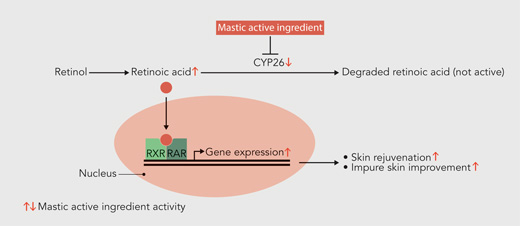
Figure 1. By inhibiting the CYP26 enzyme, Chios mastic active ingredient increases endogenous retinoic acid levels
Targeting scalp imbalance with Chios mastic active ingredient
The ability of mastic active ingredient to inhibit CYP26A1 enhances the skin’s natural renewal processes without the irritation linked to synthetic retinoids. Building on this success in facial skincare, this study explored its potential in scalp care, given the biological similarities between facial skin and the scalp. Both exhibit active sebaceous glands, comparable epidermal layers, and a tendency toward issues such as excess oil, inflammation, and microbial imbalance. These shared traits make the scalp a logical area for applying skincare actives (15). This article shows that Chios mastic, as an alternative to retinol, not only improves the skin overall condition by reducing sebum and impurities and enhancing skin density and elasticity but also promotes scalp health by balancing microbial imbalances and reducing dandruff.
Materials and Methods
To render the water-insoluble mastic useable for skin care application, a preparation with soy phospholipids containing Chios mastic gum was used. INCI (NovoRetinTM, from here on called “mastic active ingredient”): Pistacia Lentiscus Gum / Pistacia Lentiscus {Mastic} Gum {and} Lecithin {and} Pentylene Glycol {and} Glyceryl Caprylate / Caprate {and} Caprylic / Capric Triglyceride {and} Aqua / Water
28-day clinical study to evaluate the effect of Chios mastic on impure skin
This double-blind, placebo-controlled study involved a total of 44 (Asian, female) volunteers, aged 30 to 52 years (mean age: 38.3 y). Participants applied either an emulsion containing 2 % mastic active ingredient or a placebo emulsion twice daily to the face for 28 days. The parameter was impure skin (blackheads and microcysts).
The comedogenic potential was assessed by a clinician through the count of impurities across four facial zones: forehead, temples, cheeks, and chin. Visual changes were documented using macrophotographs (Nikon D80). At the end of the study, participants completed a self-evaluation questionnaire to assess perceived efficacy.
14-day clinical study on the efficacy of Chios mastic on sebum and skin hydration
This randomized, placebo-controlled half-face study was done with 23 volunteers (Asian, female) aged 21 to 48 years (mean age: 28.3 y) having oily skin and impurities. They applied a cream containing 2 % mastic active ingredient or a placebo twice daily for 14 days. Measured parameters on day 0, 7 and 14 were sebum output (Sebumeter® SM810) measured on the forehead, skin hydration (Corneometer® CM825) measured in the cheek region, and standardized facial photography (VISIA® CR).
28-day clinical study on the anti-ageing efficacy of mastic active ingredient
This randomized, placebo-controlled study involved 18 volunteers (Caucasian, female) aged 42 to 70 years (mean age: 57 y). They applied a cream containing 2 % mastic active ingredient or a placebo to one half of the face and the inner sides of each forearm twice daily for 28 days. The measured parameters were skin elasticity on the face (Cutometer® dual MPA 580, Courage + Khazaka, Germany) and density on the forearms using the Dermalab® Ultrasound system (Cortex Technology, Denmark).
28-day clinical study on the scalp-care efficacy of mastic active ingredient
This randomized, placebo-controlled trial included a total of 42 volunteers (Caucasian, female & male), aged 18 to 68 years (mean age: 46.5 y), all with oily scalp and visible dandruff. Volunteers were split into two groups and applied either a leave-on serum with 1 % mastic active ingredient or a placebo serum once daily to the entire scalp and massaged in thoroughly. The parameters were visible scalp dandruff (Aramo® ASW 300F system, 60 x magnification) and Malassezia occurrence (microbiota samples collected from the neck using sterile swabs). Swabs were streaked onto plates (ChromAgar medium) and incubated for 72 h at 30-37±1 °C under aerobic atmosphere. Grown colonies were transferred to Columbia Agar and, after microscopic preparation (Gram staining), analysed through biochemical and enzymatic tests to identify and quantify microbial strains. Malassezia was not present in all participants: it was detected in 12 individuals in the group using mastic active ingredient and in 14 individuals in the placebo group. Microbiota analysis was therefore conducted on these 26 volunteers. Dandruff severity was quantified using numeric values derived from the macrophotographs.
Results and Discussion
Improvement of impure skin with Chios mastic active ingredient
To assess the potential efficacy of Chios mastic active ingredient on skin health and appearance, its anti-comedogenic potential was evaluated in a clinical study.
Results showed that after 28 days of treatment with mastic active ingredient, a clear improvement in impure skin was observed: the number of impurities (blackheads and microcysts) decreased significantly (Figure 2).
A visible improvement of impure skin was achieved after 28 days of treatment with mastic active ingredient (Figure 3).
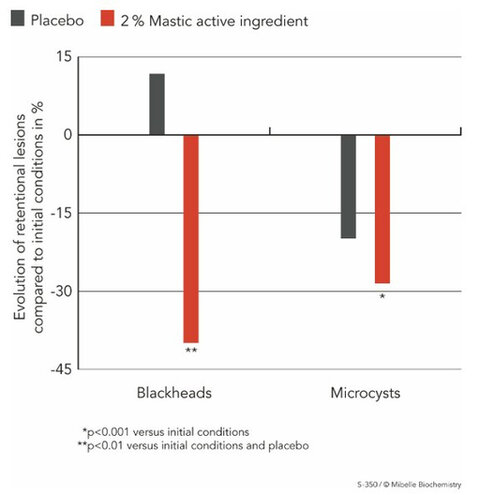
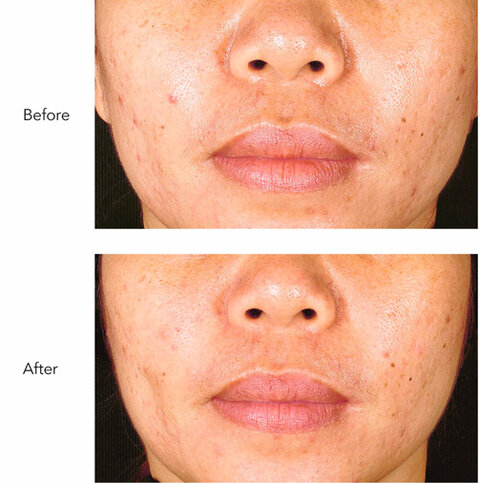
Figure 2. Reduction of skin impurities after 28 days
Figure 3. Visible improvement of impure, oily skin after 28 days
Self-evaluation results further supported the clinical findings. After 28 days of use, 95 % of participants reported their skin felt less oily, 72 % noticed smoother skin, and 73 % experienced increased suppleness. Overall, 95 % of volunteers perceived a general improvement in their skin condition.
These results highlight the effectiveness of mastic active ingredient in visibly improving the appearance and feel of impure, oily skin.
Reduced sebum production and improved skin hydration
Another clinical study evaluated the effectiveness of mastic in reducing sebum production and improving hydration. Results indicated that after 14 days of treatment with mastic active ingredient, a significant improvement in these key skin parameters was observed.
Skin hydration showed a significant increase at both time points - day 7 and day 14 - compared to baseline and placebo, demonstrating the moisturizing benefits of mastic active ingredient (Figure 4, left). On the other hand, sebum levels were significantly reduced after both 7 and 14 days of treatment compared to baseline and placebo, indicating effective sebum-regulating properties (Figure 4, right). Moreover, the visible improvement of skin condition in terms of sebum reduction was clearly visible after 2 weeks of treatment (Figure 5).
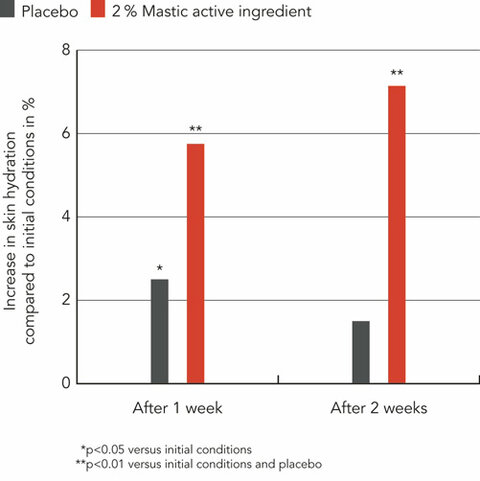
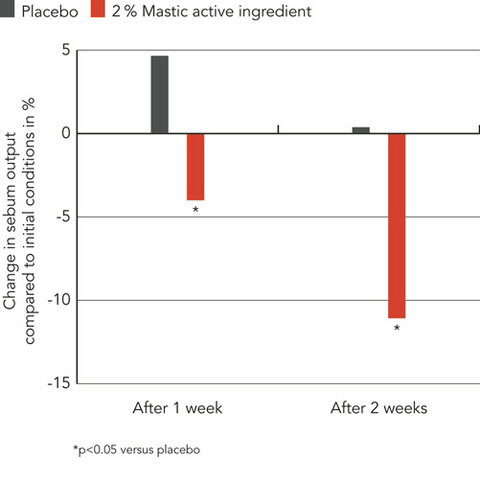
Figure 4. (left) Increase in skin hydration and (right) decrease in sebum output

Figure 5. Visible sebum reduction
Optimal skin appearance depends on a balance between reduced sebum and adequate moisture. While retinoids are known to reduce oiliness, they often dry out the skin and compromise the barrier. In contrast, mastic active ingredient demonstrates a dual action by reducing excess sebum while maintaining skin hydration, supporting a resilient, healthy, and radiant complexion.
Increase in skin elasticity and density
The third clinical study aimed to assess the ability of mastic active ingredient to improve skin elasticity and increase skin density, two key markers of anti-ageing performance.
After 28 days of treatment with mastic active ingredient, a significant improvement of skin elasticity of 20.4 % compared to initial conditions was observed in the face of the volunteers. In addition, skin density measured at the forearm improved significantly by 13.8 % after the treatment with mastic active ingredient (Figure 6, left). Ultrasound measurements clearly showed visible improvements in skin density (Figure 6, right).
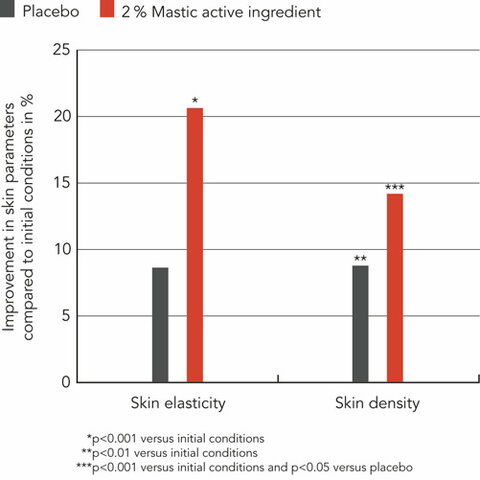
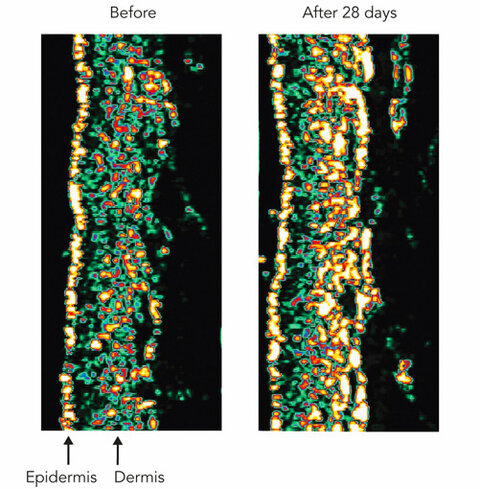
Figure 6. (left) improved skin elasticity and density and (right) ultrasound picture of skin density.
Scalp health benefits of 1 % Chios mastic active ingredient
To assess the potential efficacy of mastic active ingredient in promoting scalp health, another clinical study was performed. This study focused on the reduction of visible dandruff and the support of a healthier scalp environment by rebalancing the microbiome, particularly through the reduction of the yeast Malassezia, one of the main factors of scalp dandruff.
After 28 days of treatment, the scalp serum containing 1 % mastic active ingredient demonstrated significant efficacy in improving scalp condition. Dandruff levels were reduced by 50.4 % compared to baseline, while the placebo group showed a reduction of only 27.8 % (Figure 7, left). Microbiological analysis further supported these findings. The occurrence of Malassezia colonies was significantly reduced by 85.3 % in the mastic group, compared to a 25 % reduction with the placebo treatment (Figure 7, right).
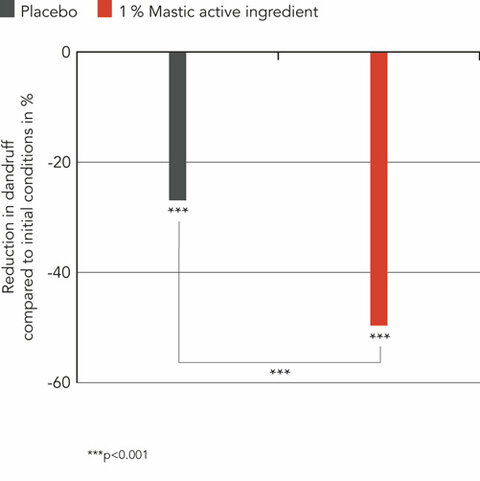
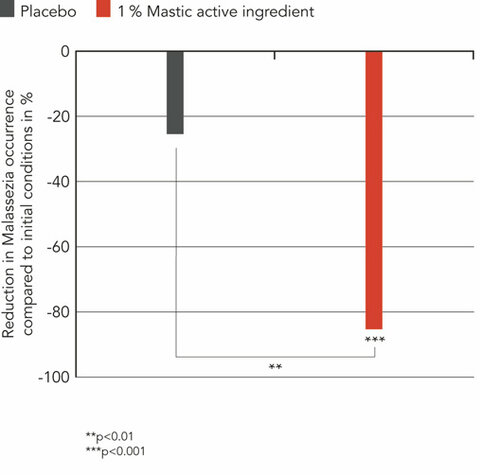
Figure 7. (left) Reduction in dandruff and (right) in Malassezia colonies.
Figure 8. Visible reduction in scalp dandruff
Beyond reducing Malassezia, mastic active ingredient supported the growth of beneficial scalp microflora, helping to maintain a balanced microbiome. No harmful bacterial growth was detected (data not shown). These effects suggest a restoration of microbial balance and reduced local inflammation, key factors for scalp comfort and regenerative capacity. Macrophotographic images also revealed a visible reduction in scalp redness, suggesting a soothing effect not observed with the placebo (Figure 8).
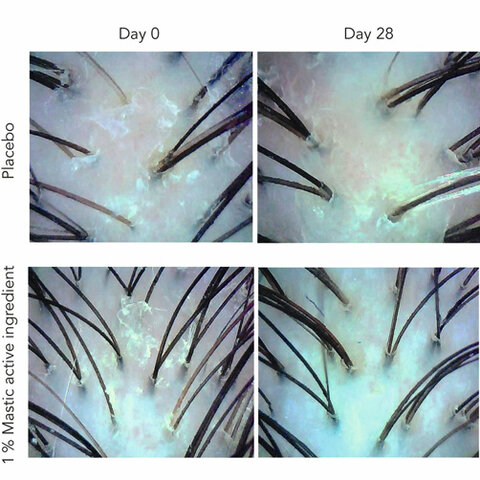
On facial skin, mastic active ingredient demonstrated a rare dual action: significantly reducing sebum production while simultaneously increasing skin hydration within just 14 days. This is particularly noteworthy, as conventional retinoids, while effective in reducing oiliness, often compromise skin moisture and barrier integrity, leading to irritation and dryness. In contrast, mastic active ingredient supports skin homeostasis, improving both texture and suppleness, as confirmed by 95 % of participants in a clinical trial. Its anti-ageing potential was further substantiated by measurable increases in skin elasticity and density after 28 days of use.
These benefits are not limited to facial applications. The scalp, which shares key physiological features with facial skin, such as sebaceous gland activity, microbial ecosystems, and barrier function, also responded positively to mastic active ingredient. In a dedicated scalp study, a 1 % mastic formulation led to a 50.4 % reduction in visible dandruff and an 85.3 % decrease in Malassezia, the yeast primarily responsible for dandruff. These improvements were accompanied by a visible reduction in redness and a rebalancing of the scalp microbiome, suggesting both anti-inflammatory and microbiota-supportive effects.
The underlying mechanism of action, inhibition of CYP26A1, sets mastic active ingredient apart from conventional retinoid alternatives. By preventing the enzymatic degradation of retinoic acid, mastic increases endogenous levels of this key metabolite, thereby enhancing its biological activity without the need for external application. This may lead to normalized cell turnover, reduced inflammation, and strengthened barrier function, benefits that are crucial for both skin and scalp health.
These findings emphasize the broad applicability and scientific significance of mastic active ingredient. It effectively combats surface-level issues like oiliness, dryness, and dandruff while simultaneously addressing their underlying causes through a gentle, retinoid-boosting mechanism. The clinical data presented in this study confirm its comprehensive performance, positioning Chios mastic active ingredient as an innovative, plant-derived alternative to conventional retinoids. Its capacity to improve diverse skin and scalp conditions makes it a uniquely integrative active component in contemporary skincare formulations. Further studies are currently underway to explore the broader cosmetic potential of mastic active ingredient, including its anti-aging effects and benefits for scalp care.
Conclusion
Chios mastic active ingredient offers a unique combination of anti-ageing, sebum-regulating, hydrating, and microbiome-balancing effects, making it an outstanding active for facial and scalp care. Unlike retinol, which often causes irritation and dryness, mastic delivers similar benefits with superior tolerability. Its ability to reinforce skin structure and support microbial balance, especially on the scalp, makes it a holistic, gentle alternative. As demand grows for natural, sustainable, multifunctional skincare, Chios mastic emerges as a science-backed solution addressing both symptoms and root causes, bridging traditional botanical knowledge with modern innovation.
Conclusion
The future of cosmetics lies in the continued evolution of holistic approaches which represents a transformative shift in the industry, merging scientific advancements, natural ingredients, and wellness principles. By understanding and embracing the interconnectedness of these elements, the cosmetics industry can cultivate products that not only enhance external beauty but also contribute to the overall well-being of individuals and the planet.
The interplay between beauty from within and topical cosmetics is the key for future products. The integration of biotechnology and green chemistry is revolutionizing cosmetic formulations, offering sustainable and biocompatible alternatives.
Developers can implement blockchain to trace the journey of ingredients from source to product. Nevertheless, the efficacy of the natural products should be scientifically proven. Marketers can communicate transparency as a brand value, and parallelly educate consumers by highlighting how specific ingredients contribute to radiant and healthy skin.
By embracing the synergy between these approaches and leveraging scientific advancements, the cosmetics industry can provide consumers with comprehensive beauty solutions that cater to both internal and external dimensions of beauty.
Surfactant Applications
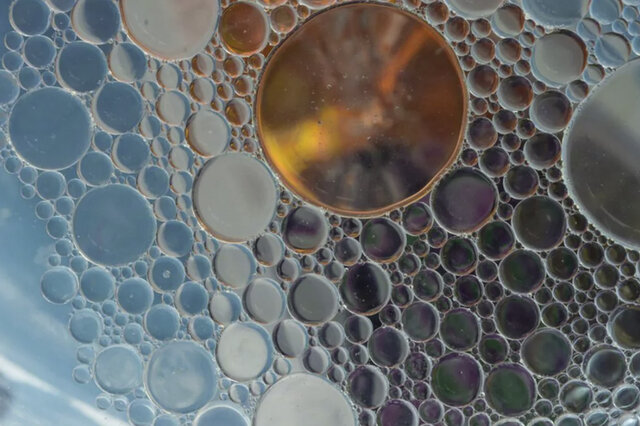
The application area lends itself particularly well to the use of AI. Active today in this area is the US company Potion AI (6). The company provides AI-powered formulation tools for beauty and personal care R&D. Their offerings include Potion GPT, next generation ingredient and formula databases and AI document processing. Potion’s work could have a significant impact on the entire surfactant value chain, from raw material suppliers to end consumers. By using their GPT technology, they can help target work toward novel surfactant molecules that have optimal properties for specific applications. By using their ingredient and formula databases, they can access and analyze a vast amount of data on surfactant performance, safety, and sustainability. By using their AI document processing, they can extract and organize relevant information from patents, scientific papers, and regulatory documents. These capabilities could enable Potion AI's customers to design and optimize surfactant formulations that are more effective, eco-friendly, and cost-efficient. A particularly interesting application for this type of capability is deformulation.
Deformulation is the process of reverse engineering a product's formulation by identifying and quantifying its ingredients. Deformulation can be used for various purposes, such as quality control, competitive analysis, patent infringement, or product improvement. However, deformulation can be challenging, time-consuming, and costly, as it requires sophisticated analytical techniques, expert knowledge, and access to large databases of ingredients and formulas.
AI can potentially enhance and simplify the deformulation process by using data-driven methods to infer the composition and structure of a product from its properties and performance. For example, AI can use machine learning to learn the relationships between ingredients and their effects on the product's characteristics, such as color, texture, fragrance, stability, or efficacy. AI can also use natural language processing to extract and analyze information from various sources, such as labels, patents, literature, or online reviews, to identify the possible ingredients and their concentrations in a product.
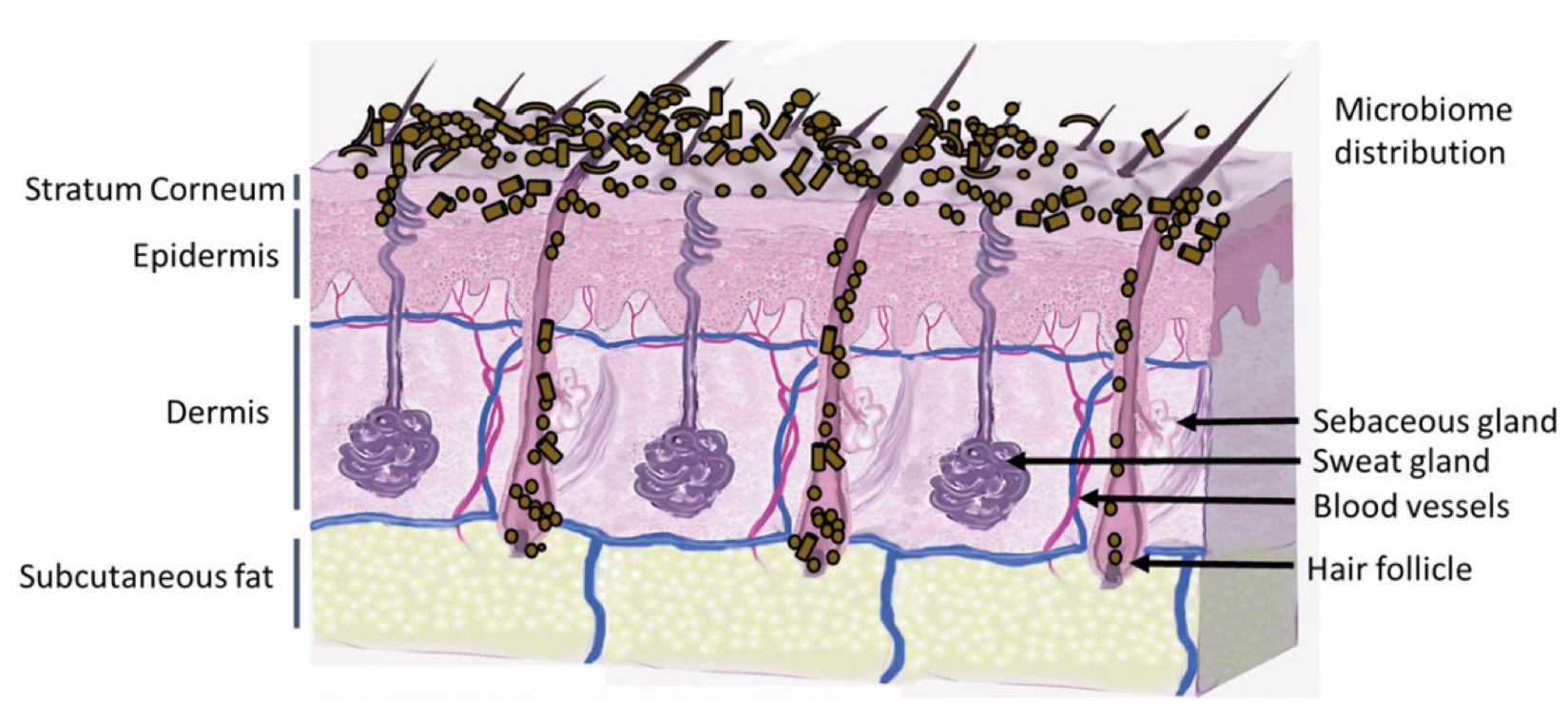
Figure 2. Skin Section with Microbiome. Most microorganisms live in the superficial layers of the stratum corneum and in the upper parts of the hair follicles. Some reside in the deeper areas of the hair follicles and are beyond the reach of ordinary disinfection procedures. There bacteria are a reservoir for recolonization after the surface bacteria are removed.
References and notes
- Zasada M, Budzisz E. Retinoids: active molecules influencing skin structure formation in cosmetic and dermatological treatments. Postepy Dermatol Alergol. 2019;36(4):392-7. https://pubmed.ncbi.nlm.nih.gov/31616211/
- van de Kerkhof PC. Update on retinoid therapy of psoriasis in: an update on the use of retinoids in dermatology. Dermatol Ther. 2006;19(5):252-63. https://onlinelibrary.wiley.com/doi/10.1111/j.1529-8019.2006.00082.x
- Temova Rakusa Z, Skufca P, Kristl A, Roskar R. Retinoid stability and degradation kinetics in commercial cosmetic products. J Cosmet Dermatol. 2021;20(7):2350-8. https://pubmed.ncbi.nlm.nih.gov/33206444/
- Yin S, et al. Retinoids activate the irritant receptor TRPV1 and produce sensory hypersensitivity. J Clin Invest. 2013;123(9):3941-51. https://pubmed.ncbi.nlm.nih.gov/23925292/
- Failloux N, Bonnet I, Perrier E, Baron MH. Effects of light, oxygen and concentration on vitamin A1. J Raman Spectrosc. 2004;35(2):140-7. https://analyticalsciencejournals.onlinelibrary.wiley.com/doi/10.1002/jrs.1116
- Mukherjee S, et al. Retinoids in the treatment of skin aging: an overview of clinical efficacy and safety. Clin Interv Aging. 2006;1(4):327-48. https://pubmed.ncbi.nlm.nih.gov/18046911/
- Zhong J, Zhao N, Song Q, Du Z, Shu P. Topical retinoids: Novel derivatives, nano lipid-based carriers, and combinations to improve chemical instability and skin irritation. J Cosmet Dermatol. 2024;23(10):3102-15. https://pubmed.ncbi.nlm.nih.gov/38952060/
- Heise R, et al. Skin retinoid concentrations are modulated by CYP26AI expression restricted to basal keratinocytes in normal human skin and differentiated 3D skin models. J Invest Dermatol. 2006;126(11):2473-80. https://pubmed.ncbi.nlm.nih.gov/16778795/
- Verfaille CJ, Borgers M, van Steensel MA. Retinoic acid metabolism blocking agents (RAMBAs): a new paradigm in the treatment of hyperkeratotic disorders. J Dtsch Dermatol Ges. 2008;6(5):355-64. https://pubmed.ncbi.nlm.nih.gov/17941881/
- Panagiota S, et al. Revealing the Potential of Chios Mastic Gum and Its Constituents for Cosmetic Applications through Chemical Profiling and Biological Evaluation. Cosmetics. 2024;11(5):155. https://www.mdpi.com/2079-9284/11/5/155
- Dimas KS, Pantazis P, Ramanujam R. Review: Chios mastic gum: a plant-produced resin exhibiting numerous diverse pharmaceutical and biomedical properties. In Vivo. 2012;26(5):777-85. https://pubmed.ncbi.nlm.nih.gov/22949590/
- Haghdoost F, et al. Pistacia atlantica Resin Has a Dose-Dependent Effect on Angiogenesis and Skin Burn Wound Healing in Rat. Evid Based Complement Alternat Med. 2013;2013:893425. https://pubmed.ncbi.nlm.nih.gov/24285978/
- Pachi VK, et al. Traditional uses, phytochemistry and pharmacology of Chios mastic gum (Pistacia lentiscus var. Chia, Anacardiaceae): A review. J Ethnopharmacol. 2020;254:112485. https://pubmed.ncbi.nlm.nih.gov/32092498/
- Szymanski L, et al. Retinoic Acid and Its Derivatives in Skin. Cells. 2020;9(12). https://pubmed.ncbi.nlm.nih.gov/33322246/
- Eisenstein M. The skin microbiome. Nature. 2020;588(7838):S209. https://www.nature.com/articles/d41586-020-03523-7
